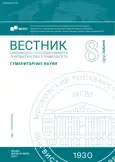Latin Certificates of Authenticity for Relics: History, Text, Translation
- Authors: Golikova M.S.1
-
Affiliations:
- Moscow State Linguistic University
- Issue: No 8(876) (2023)
- Pages: 130-137
- Section: Literary criticism
- URL: https://bakhtiniada.ru/2542-2197/article/view/350416
- ID: 350416
Cite item
Full Text
Abstract
Relic Certificates of Authenticity is a document containing information about a relic and confirming its authenticity. Such papers, traditionally drawn up in Latin, are a unique example of a mixture of the official style of the Latin language of the New Time, which was used in Western Europe in the field of office work, and Ecclesiastical Latin. The relevance of the topic is related to the importance of studying certificates both for translation into Russian, which is required to certify this document in order to verify the authenticity of the relics, and to obtain information about the saints and the cult of their veneration.
About the authors
Maria Sergeevna Golikova
Moscow State Linguistic University
Author for correspondence.
Email: golikofff@list.ru
PhD (Philosophy), Associate Professor at the Department of Classical Philology
Russian FederationReferences
- Popov, I. V. (1997). O pochitanii svyatykh moshchey = About the veneration of holy relics. Zhurnal Moskovskoi patriarkhii, 1, 66–73. (In Russ.)
- Gagneux, Y. (2009). À propos des reliquaires, questions de méthode. In Situ, Revue des patrimoines, 11. https://journals.openedition.org/insitu/9909 (accessed: 21.05.2023).
- Code of Canon Law. (2007). Moscow: Institute of Philosophy, Theology and History of St. Thomas. (In Russ.)
- Instruction on Relics in the Church: Authenticity and Preservation. (2017). Rome. https://www.vatican.va/roman_curia/congregations/csaints/documents/rc_con_csaints_doc_20171208_istruzione-reliquie_en.html (accessed: 21.05.2023).
- Delisle, M. L. (1884). Authentiques de reliques de l’époque mérovingienne. Mélanges de l’école française de Rome Année, 4, 3–8.
- Olds, K. (2012). The Ambiguities of the Holy: Authenticating Relics in Seventeenth-Century Spain. Renaissance Quarterly, 65(1), 135–184.
- Bertrand, P. (2006). Authentiques de reliques: authentiques ou reliques? Dans Le Moyen Age, 112, 363–374.
- Freeman, Ch. (2011). Holy Bones, Holy Dust: How Relics Shaped the History of Medieval Europe. New Haven: Yale University Press.
- Durand, J. (2020). Reliques et reliquaries. Reliques et reliquaires byzantins: de Constantinople à la Flandre et au Hainaut au XIIIe siècle. Arte medieval, 4(10), 81–102.
- Alterauge, A., Becker, Th., Berndt, B., Jackowski, Ch., Lösch, S. (2016). Testing “Saintly” Authenticity: Investigations on Two Catacomb Saints. Radiographics, 36(2), 573–579.
- Thurston, H. (1907). Relics. The Catholic Encyclopedia (vol. 12, pp. 734–738). New York: Robert Appleton Company.
- Du Cange, Ch. F. (1883–1887). Glossarium mediæ et infimæ latinitatis. Niort: L. Favre. http://ducange.enc.sorbonne.fr (accessed: 21.05.2023).
- Fourth Lateran Council. (1215). https://www.papalencyclicals.net/councils/ecum12-2.htm (accessed: 21.05.2023).
- Calvin, J. A. (1854). Treatise on Relics. United Kingdom: Johnstone and Hunter.
- Borromeo, С. (1577). Instructionum fabricae et supellectilis ecclesiasticae. Milano: P. Pontius.
- Thomas Merton Center Collection. (2023). Authentics (certificates of authenticity for relics) for two relics of St. Thérèse of Lisieux (Saint Thérèse of the Child Jesus and the Holy Face, O.C.D.) in Thomas Merton’s possession. https://merton.bellarmine.edu/s/Merton/item/41019 (accessed: 21.05.2023).
- Leclercq H. (1907). Ecclesiastical Abbreviations. The Catholic Encyclopedia (vol. 1, pp. 64–81). New York: Robert Appleton Company.
- Lettere della famiglia Mozart. (2023). https://mozartiana.org/mozartletters/?page=persone&NNN=1840&CCC=4127#D4127 (accessed:21.05.2023).
Supplementary files










